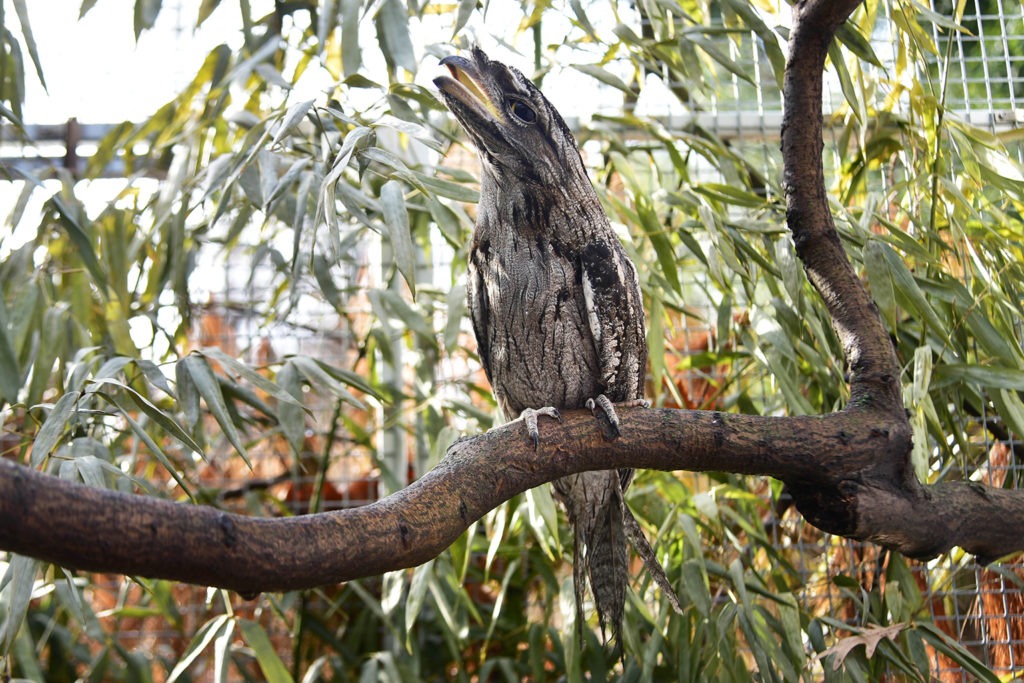Overview
“Where I Live”
Tawny frogmouths are native to most of mainland Australia as well as the island state of Tasmania. They live where there are trees – in parks, forests, and woodlands.
“How I Live There”
By day, tawny frogmouths perch very still in trees with their eyes slit to narrow cracks. The color and pattern of their feathers offer excellent camouflage, and they can easily be overlooked or mistaken for tree bark.
At night, tawny frogmouths hunt. They have large eyes and a keen sense of hearing well adapted for nocturnal activity. They are ambush predators that sit very still, watching for prey from a high perch, and then drop down silently to snatch a meal. They are opportunistic carnivores that feed primarily on insects but will also take invertebrates, small mammals, reptiles, frogs, and birds. They have stiff whisker-like bristles around their beaks that help them detect flying insects and protect against bites and stings.
Tawny frogmouths live in pairs, roosting near each other at night and working together during the day to guard territory. They make a soft, deep “oom-ooom-ooom” call and a hissing or buzzing cry when threatened.
“Making My Mark”
Frogmouths play a vital role in their ecosystems, including agricultural areas, by helping to control populations of locusts, grasshoppers, mice, and the devastating Christmas beetle that ravages eucalyptus trees.
Raising Young
Tawny frogmouths pair up for life. They breed during the spring, which in Australia is from about August to December. Females lay clutches of 1-3 eggs that hatch after a 30-day incubation period. Male and female both incubate the eggs, each taking up to 12-hour shifts. Both parents care for the offspring once hatched. The chicks leave the nest after 25-35 days, once they are fully fledged.
“What Eats Me”
Carpet pythons, foxes, domestic cats and dogs, and other relatively large predators are known to prey on tawny frogmouths. When first threatened, tawny frogmouths freeze with their heads craned upwards, feathers flattened, and eyes reduced to slits. This behavior, called “stumping, ”gives them the camouflaged appearance of a broken branch. Often, this successfully tricks a predator into moving on. If the trick doesn’t work, though, and the tawny frogmouth still feels threatened, it will take the opposite tactic. It will puff up its feathers, snap its yellow bill, and open its gaping mouth in order to look large and intimidating.
Conservation
Tawny frogmouths are listed as a species of least concern by the IUCN, the world’s leading conservation organization. They are common throughout their range, but still have specific threats. They are often road-kill victims because they crash into cars when pursuing insects illuminated by head beams or road lights. With increased urbanization and development, they also are threatened by the ongoing loss of mature trees that they usually nest and perch in and by pesticide poisoning.
Taxonomy
- Kingdom: Animalia
- Phylum: Chordata
- Subphylum: Vertebrata
- Class: Aves
- Genera: Podargus
- Species: strigoides
What is an Animal Ambassador?
The Maryland Zoo refers to its special collection of education program animals as “Animal Ambassadors.” The Zoo currently cares for more than 60 Animal Ambassadors, representing more than 40 species, both native and exotic. These animals are managed separately from the rest of the Zoo’s collection and cannot be seen on exhibit at the Zoo. However, many can be seen up close and personal on a rotating basis at Creature Encounters, the Zoo’s outdoor education center; at camp and school programs at the Zoo; as featured participants in community-based Outreach programs; and at special events on and off Zoo grounds.
Animal Ambassadors spend countless hours working with their human handlers, developing bonds of trust and communication that will allow them to appear in front of audiences large and small. They are not show animals. They behave naturally, focusing audiences’ attention on their natural behaviors and adaptations and giving living, breathing meaning to concepts and topics that students may be studying.
Animal Ambassadors travel all over the state of Maryland and beyond, and many also make local and national media appearances, educating about wildlife while representing the Zoo and its commitments to animal welfare and conservation.
What is The Animal Embassy?
The Animal Embassy at The Maryland Zoo is an off-exhibit area that is not open to the public. It is where the Zoo’s “Animal Ambassadors,” or education program animals, live. The Embassy is home to more than 60 individual animals representing more than 40 different species. It is staffed by its own dedicated group of keepers and volunteers and has both indoor and outdoor living space for the animals.


